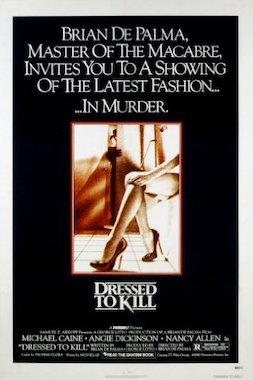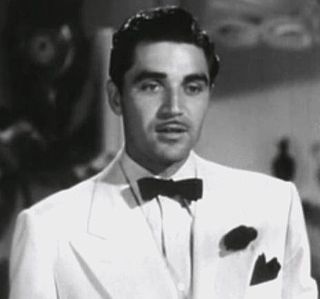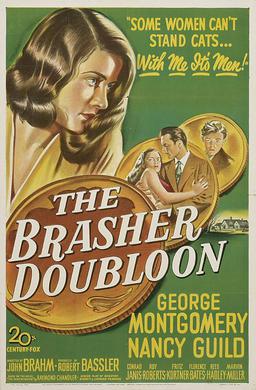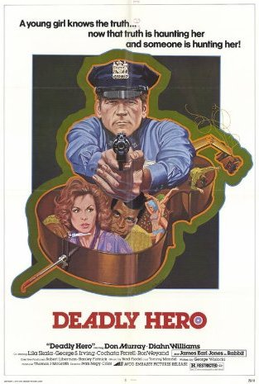
Dressed to Kill is a 1980 American erotic psychological thriller film written and directed by Brian De Palma, and starring Michael Caine, Angie Dickinson and Nancy Allen. It depicts the events leading up to the brutal murder of a New York City housewife (Dickinson) before following a prostitute (Allen) who witnesses the crime, and her attempts to solve it with the help of the victim's son. It contains several direct references to Alfred Hitchcock's 1960 film Psycho.

Walter Benjamin Lantz was an American cartoonist, animator, producer and director best known for founding Walter Lantz Productions and creating Woody Woodpecker.

Margaret Alexis Smith was a Canadian-born American actress, pin-up girl and singer. She appeared in several major Hollywood films in the 1940s and had a notable career on Broadway in the 1970s, winning a Tony Award in 1972 for the Stephen Sondheim-James Goldman musical Follies.

Hell Divers is a 1932 American pre-Code black-and-white film from Metro-Goldwyn-Mayer starring Wallace Beery and Clark Gable as a pair of competing chief petty officers in early naval aviation. The film, made with the cooperation of the United States Navy, features considerable footage of flight operations aboard the Navy's second aircraft carrier, the USS Saratoga, including dramatic shots of takeoffs and landings filmed from the Curtiss F8C-4 Helldiver dive bombers after which the movie was named.

Joseph H. Lewis was an American B-movie film director whose stylish flourishes came to be appreciated by auteur theory-espousing film critics in the years following his retirement in 1966. In a 30-year directorial career, he directed numerous low-budget westerns, action pictures, musicals, adventures, and thrillers. Today he is remembered for mysteries and film noir stories: My Name Is Julia Ross (1945) and So Dark the Night (1946) as well as his most highly regarded features, 1950's Gun Crazy, which spotlighted a desperate young couple who embark on a deadly crime spree, and the 1955 film noir The Big Combo, with its stunning cinematography by John Alton.

Steve Cochran was an American film, television and stage actor. He attended the University of Wyoming. After a stint working as a cowboy, Cochran developed his acting skills in local theatre and gradually progressed to Broadway, film and television.

Animal Factory is a 2000 neo-noir film directed by Steve Buscemi and starring Willem Dafoe, Edward Furlong, Danny Trejo, John Heard, Mickey Rourke, Tom Arnold, Seymour Cassel, Shell Galloway and Mark Boone, Jr. Set in San Quentin, the film is about life in prison. It is based on the novel of the same name by Eddie Bunker who plays the part of Buzzard in the film.

Ralph Meeker was an American film, stage, and television actor. He first rose to prominence for his roles in the Broadway productions of Mister Roberts (1948–1951) and Picnic (1953), the former of which earned him a Theatre World Award for his performance. In film, Meeker is perhaps best known for his portrayal of Mike Hammer in Robert Aldrich's 1955 Kiss Me Deadly.

The Brasher Doubloon is a 1947 American crime film noir directed by John Brahm and starring George Montgomery and Nancy Guild. It is based on the 1942 novel The High Window by Raymond Chandler.

The Reincarnation of Peter Proud is a 1975 American psychological horror film directed by J. Lee Thompson, and starring Michael Sarrazin, Margot Kidder, and Jennifer O'Neill. It follows a university professor who, after experiencing a series of bizarre nightmares, comes to believe he is the reincarnation of someone else. It is based on the 1973 novel of the same title by Max Ehrlich, who adapted the screenplay.

Decoy is a 1946 American film noir starring Jean Gillie, Edward Norris, Robert Armstrong, Herbert Rudley, and Sheldon Leonard. Directed by Jack Bernhard, it was produced by him and Bernard Brandt as a Jack Bernhard Production, with a screenplay by Nedrick Young based on an original story by Stanley Rubin.
Darrell Wallace Calker was an American composer and arranger who worked on films and animated cartoons.

Don't Answer the Phone! is a 1980 American psychological horror film co-written and directed by Robert Hammer.

Cry Terror! is a 1958 American crime thriller film starring James Mason, Inger Stevens, and Rod Steiger. The story was written and directed by Andrew L. Stone. Neville Brand, Jack Klugman and Angie Dickinson appear in support.

Deadly Hero is a 1975 American neo noir thriller film starring Don Murray, Diahn Williams, James Earl Jones, Lilia Skala and Treat Williams in his film debut. It was directed by Ivan Nagy from a screenplay by George Wislocki and Don Petersen. Released in limited locales in 1975 with an R rating from the Motion Picture Association of America, it was distributed by AVCO Embassy. It opened to mixed, mostly negative reviews, and was considered a commercial failure.

The Lone Wolf in London is a 1947 American mystery crime film directed by Leslie Goodwins and starring Gerald Mohr, Nancy Saunders and Eric Blore. The picture features the fictional Scotland Yard detective the Lone Wolf who travels to London, and solves the mystery of some missing jewels. It was the penultimate Lone Wolf film, followed by The Lone Wolf and His Lady in 1949, and the last for Mohr in the lead role.

Breakdown is a 1952 American crime film noir directed by Edmond Angelo starring Ann Richards, William Bishop and Anne Gwynne. It was the last film of Richards before she retired.

The Crowded Sky is a 1960 Technicolor drama film distributed by Warner Bros., produced by Michael Garrison, directed by Joseph Pevney and starring Dana Andrews, Rhonda Fleming and Efrem Zimbalist Jr. The film is based on the 1960 novel of the same name by Hank Searls.

Zuma Beach is a 1978 TV movie written by John Carpenter and William Schwartz, directed by Lee H. Katzin and starring Suzanne Somers.
The National Student Film Institute (NSFI), formerly the Los Angeles Student Film Institute (LASFI), was founded in 1978 by Brenda Norman, Dave Master, Jutti Marsh and Ralph Rogers as a festival for films made by children from kindergarten through ninth grade. Two years later it was expanded to include the work of all high school students. The first of what became an annual festival included approximately 350 students who entered 125 films. By 1993, the Student Film Festival involved over two thousand students throughout the Los Angeles area, who together entered over 300 films. The film festival was held each year at the Directors Guild Theater in Hollywood.


















